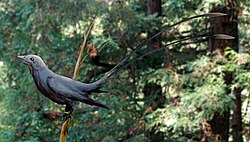Confuciusornis
Confuciusornis is a genus of primitive crow-sized birds from the Lower Cretaceous. It was found in the Yixian and Jiufotang Formations of China, dating from 125 to 120 million years ago. The bird was named after the Chinese moral philosopher Confucius (551–479 BC).
| Confuciusornis Temporal range: Early Cretaceous,
| |
|---|---|

| |
| C. sanctus fossil preserving long wing and tail feathers. | |
| Scientific classification | |
| Kingdom: | |
| Superorder: | |
| Order: | |
| Family: | |
| Type species | |
| †Confuciusornis sanctus Hou et al., 1995
| |
| Species | |
| |
| Synonyms | |
|
C. sanctus
| |
Like modern birds, Confuciusornis had a toothless beak, but close relatives of modern birds such as Hesperornis and Ichthyornis were toothed. This shows that the loss of teeth occurred more than once, in Confuciusornis and in ancestors of modern birds. This is an example of convergent evolution.
Confuciusornis is the oldest known bird to have a beak.[1] It is also the first known bird to have lost the long tail of Archaeopteryx and develop fused tail vertebrae (a pygostyle).[2]
Confuciusornis is one of the most abundant vertebrates found in the Yixian Formation, and several hundred complete, articulated specimens have been found.[3]
The proportions of the toes suggest that they were used for both walking and perching, while the large claws of the thumb and third finger were probably used for climbing. The head probably had a small crest or tuft.
Flight
The orientation of the shoulder joint was sideways, instead of angled upward as in modern birds; this means that Confuciusornis was unable to lift its wings above its back. Like Archaeopteryx, it was thus incapable of the upstroke required for flapping flight.[4] This conclusion is not established at present. Peters sees Confuciusornis as capable of flapping flight but specialising in soaring flight.[5] The bird's weight has also been debated.
An argument from Gregory Paul noted that Confuciusornis is commonly found as large groups in lake bottom sediments with little to no evidence of the bodies being moved after death. It would be highly unusual for gliding animals to be found in such large numbers in deep water. Rather, this evidence suggests that Confuciusornis traveled in large flocks over the lake surfaces, a habitat consistent with a flying animal.[6]
Colour
In early 2010, a group of scientists led by Zhang Fucheng examined fossils with preserved melanosomes (organelles which contain colour pigments). By studying the fossils with an electron microscope, they found melanosomes preserved in a fossil Confuciusornis specimen.[7] The melanosomes where of two types, which indicates that Confuciusornis had hues of grey, red/brown and black, possibly something like the modern zebra finch.[8][9]
Confuciusornis Media
C. sanctus specimen, Cincinnati Museum of Natural History and Science; specimens have been distributed worldwide
Due to the crushed nature of the specimens, the temporal region of the skull has been reconstructed in various ways, here in a diapsid configuration (right in red) suggested by Chiappe and colleagues, 1999
Diagram of the arm bones; note the hole in the humerus
Patagium impressions of Confuciusornis (a, b) compared to the patagium of a chicken (c, d)
Restoration of the related Eoconfuciusornis
References
- ↑ Ivanov M., Hrdlickova S. & Gregorova R. 2001. The complete encyclopedia of fossils. Rebo Publishers, Nederlands. p312
- ↑ Clarke, Julia. A. Norell Mark. A. 2002. The morphology and phylogenetic position of Apsaravis ukhaana from the Late Cretaceous of Mongolia. American Museum Novitates, #3387, American Museum of Natural History, New York, NY
- ↑ Xu X. and Norell M.A. 2006. Non-Avian dinosaur fossils from the Lower Cretaceous Jehol Group of western Liaoning, China. Geological Journal, 41: 419–437.
- ↑ Senter, P. 2006. Scapular orientation in theropods and basal birds, and the origin of flapping flight. Acta Palaeontologica Polonica, 51(2): 305–313.
- ↑ Peters D.S. & Q. Ji, 1999. Muβte Confuciusornis klettern? J. Ornithol. 140(1): 41–50
- ↑ Paul, G.S. 2010. Comment on 'Narrow primary feather rachises in Confuciusornis and Archaeopteryx suggest poor flight ability'. Science 330 (6002): 320.
- ↑ Zhang F., X. Xu, M.J. Benton, Stuart L. Kearns et al. 2010. Fossilized melanosomes and the colour of Cretaceous dinosaurs and birds. Nature, 463: 1075-1078. See the article online.
- ↑ "e!Science News: The color of dinosaur feathers discovered". Archived from the original on 2021-12-18. Retrieved 2010-12-24.
- ↑ "ScienceNOW: The Lost World, now in colors by Sverker Lundin. January, 27 2010". Archived from the original on 2010-08-13. Retrieved 2010-12-24.









